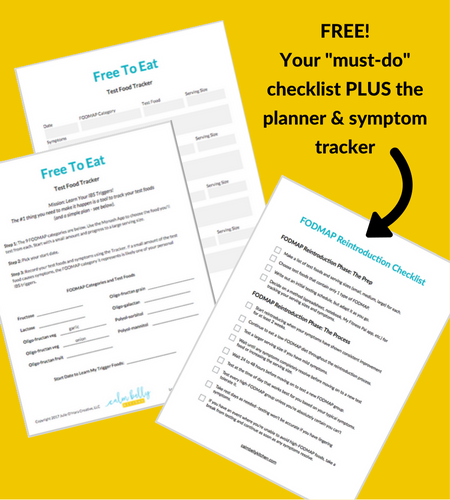Share it on Pinterest!
During a group coaching session recently, one of my awesome clients asked if I had a great low-FODMAP pizza recipe that wouldn't trigger her IBS symptoms. I said no because I only use ONE recipe: my favorite classic, chewy-crispy, stone-fired pizza dough.
“So what gluten-free flour do you use?” Another client asked.
When I clarified that I use regular all-purpose wheat flour for my pizza, minds were blown.
In that moment a light-bulb went on in my head: No one talks about life AFTER the FODMAP Diet.
You might not know you can bring certain high-FODMAP foods back into your life because nobody bothered to explain it.
You might know about avoiding high-FODMAP food and testing FODMAPs (i.e. the Reintroduction Phase), but what about the end goal of this process?
To put it plainly, less FODMAPs = less IBS symptoms isn’t the full story. The end goal is to eat some pizza, or crisp apples, or ice cream - or whatever food you’ve loved and lost!
The end goal isn’t to restrict all high-FODMAP foods forever. The goal is learning your unique triggers for your IBS symptoms.
When you know your personal triggers and tolerance levels, you can...
Bring back high-FODMAP foods that don’t cause your stomach issues
Know what portions of high-FODMAP foods trigger your symptoms, and eat smaller amounts of those
Stop avoiding “natural flavors” in foods that might have a tiny amount of onion or garlic
Go to restaurants and not shy away from every bit of wheat and lactose on the menu
Choose what you’ll eat based on solid knowledge of how food affects your body, instead of guessing and fearing the consequences
For me, this means my favorite pizza is back in my life - I learned wheat doesn’t trigger my IBS symptoms. Here’s what it means for some of my clients…
Testing FODMAPs and learning their personal triggers is how these ladies went from anxiety and restriction to having fun eating again.
And it doesn’t take tons of time or willpower to test FODMAPs. The key is to create your testing plan, set a date, and track your results.
In case you missed it, I designed a tool to make this quick and simple. Click here to get the FREE Reintro Checklist and Tracker for the FODMAP Challenge Phase!
Avoiding every high-FODMAP food 24/7 is good when you use it for a purpose: Learning about your body and giving it a clean slate. Kind of like hitting the reset button.
But if you’re doing it with no purpose or end goal, you’re depriving yourself of a huge variety of food when it’s not necessary.
Going through the process and testing the different FODMAP categories is worth it because of what you get in the end: You know what triggers your IBS and what doesn’t so you’re free to eat without fear.
It can feel like discovering the FODMAP diet is what changes your life, but it’s not.
Knowing your triggers is what changes your life - It breaks you out of food jail and leads you to freedom. And if freedom looks like pizza to you, you owe it to yourself to find out.
Leave a comment and tell me what you want your life to look like after FODMAP! Is the thought of eating high-FODMAP foods again blowing your mind? (and if you just want my pizza recipe, don’t hesitate to ask!)













